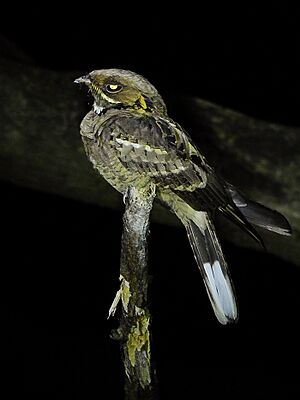Jerdon's nightjar facts for kids
Quick facts for kids Jerdon's nightjar |
|
|---|---|
 |
|
| C. a. atripennis
Mangaon, Raigad, Maharashtra |
|
| Conservation status | |
| Scientific classification | |
| Genus: |
Caprimulgus
|
| Species: |
atripennis
|
 |
|
Jerdon's nightjar (scientific name: Caprimulgus atripennis) is a cool bird found in southern India and Sri Lanka. It's a medium-sized nightjar, known for being active at night. This bird has a very special call that sounds like someone tapping a wooden plank. Each tap ends with a shaky sound, like a "quaver." The bird is named after Thomas C. Jerdon, who first described it.
Contents
About Jerdon's Nightjar
The Jerdon's nightjar was first described by Thomas C. Jerdon in 1845. For a while, some scientists thought it was just a type of long-tailed nightjar. But in 1987, experts noticed that Jerdon's nightjars and large-tailed nightjars lived in the same areas without mixing. This showed they were different species.
Later studies on their unique calls confirmed that Jerdon's nightjar is its own distinct species. The type of Jerdon's nightjar found in Sri Lanka is called C. a. aequabilis.
What Does It Look Like?
Like other nightjars, this bird has a wide mouth and long wings. Its feathers are soft and fluffy. It is also active at night. The Jerdon's nightjar is about 26 centimeters (10 inches) long. This makes it a bit bigger than the Indian nightjar.
You can tell it apart from other nightjars by its tail, which has stripes. It also has a reddish-brown color on the back of its neck and stripes on its wings. The top of its head has fine patterns, making it look almost one color. It has a blackish collar around its neck. Male Jerdon's nightjars have a white patch on each wing.
Its feathers are mostly mixed shades of buff and brown. This helps it blend in with its surroundings, especially in dark tropical woodlands. It has a clear white patch on its throat, similar to the long-tailed nightjar. However, its tail is shorter. The Sri Lankan type, aequabilis, is a little smaller and darker.
Its usual call is a quick, repeated "ch-woo-woo." It can also make a sound like a frog croaking.
Where Does It Live and What Does It Do?
Jerdon's nightjar lives in open woodlands, bushy areas, and farmlands. It is a nocturnal bird, meaning it is active at night. After the sun goes down, it flies with a smooth, quiet, fluttering motion. It might look a bit like a large moth flying around.
During the day, the Jerdon's nightjar rests silently on the ground. Its feathers help it blend in perfectly with the soil, making it very hard to spot.
This bird eats insects that are active at night, like moths. Unlike the Indian nightjar, this species usually does not rest on roads at night. Instead, it prefers to land on bushes. This makes it harder to see with car headlights. Even though it calls from trees, it rests on the ground.
How Does It Reproduce?
The breeding season for Jerdon's nightjars is from March to July in India. In Sri Lanka, it is from February to May. These birds do not build a nest. Instead, they lay two eggs directly on the bare ground. The eggs have a marbled pattern.
The parent bird sits on the eggs, covering them closely with its camouflage feathers. This helps to protect them. After hatching, the chicks can crawl away from the nest very quickly. If they sense danger, they will hide among leaves to stay safe.
Is It Endangered?
Jerdon's nightjar has been listed as a Least-concern species by the IUCN Red List since 2004. This means it is not currently at high risk of becoming endangered. It lives across a large area, and its population is thought to be stable.



